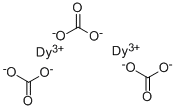DYSPROSIUM CHLORIDE
- CAS NO.:10025-74-8
- Empirical Formula: Cl3Dy
- Molecular Weight: 268.86
- MDL number: MFCD00010984
- EINECS: 233-039-9
- SAFETY DATA SHEET (SDS)
- Update Date: 2025-01-27 09:38:02

What is DYSPROSIUM CHLORIDE?
Chemical properties
-20 mesh with 99.9% purity; white powder(s) [STR93]; yellow, shining crystal(s) [MER06] [CER91]
The Uses of DYSPROSIUM CHLORIDE
It is used as a precursor for the preparation of other dysprosium?salts.
The Uses of DYSPROSIUM CHLORIDE
Dysprosium Carbonate has specialized uses in laser glass, phosphors and Dysprosium Metal halide lamp. Dysprosium is used in conjunction with Vanadium and other elements, in making laser materials and commercial lighting. Dysprosium is one of the components of Terfenol-D,which is employed in transducers, wide-band mechanical resonators, and high-precision liquid-fuel injectors.
Safety Profile
Poison by intraperitoneal route. Mildly toxic by ingestion. When heated to decomposition it emits toxic fumes of Cl-. See also CHLORIDES and RARE EARTHS
Properties of DYSPROSIUM CHLORIDE
| Melting point: | 680 °C(lit.) |
| Boiling point: | 1500°C |
| Density | 3.67 g/mL at 25 °C(lit.) |
| storage temp. | under inert gas (nitrogen or Argon) at 2-8°C |
| solubility | soluble in H2O, methanol |
| form | Powder |
| color | white |
| Specific Gravity | 3.67 |
| Water Solubility | Soluble in water. |
| Sensitive | Hygroscopic |
| Merck | 14,3482 |
| CAS DataBase Reference | 10025-74-8(CAS DataBase Reference) |
| EPA Substance Registry System | Dysprosium chloride (DyCl3) (10025-74-8) |
Safety information for DYSPROSIUM CHLORIDE
| Signal word | Warning |
| Pictogram(s) |
 Exclamation Mark Irritant GHS07 |
| GHS Hazard Statements |
H315:Skin corrosion/irritation H319:Serious eye damage/eye irritation H335:Specific target organ toxicity, single exposure;Respiratory tract irritation |
| Precautionary Statement Codes |
P261:Avoid breathing dust/fume/gas/mist/vapours/spray. P264:Wash hands thoroughly after handling. P264:Wash skin thouroughly after handling. P271:Use only outdoors or in a well-ventilated area. P280:Wear protective gloves/protective clothing/eye protection/face protection. P302+P352:IF ON SKIN: wash with plenty of soap and water. P305+P351+P338:IF IN EYES: Rinse cautiously with water for several minutes. Remove contact lenses, if present and easy to do. Continuerinsing. |
Computed Descriptors for DYSPROSIUM CHLORIDE
New Products
4,4-Difluoropiperidine hydrochloride tert-butyl 9-methoxy-3-azaspiro[5.5]undecane-3-carboxylate Indole Methyl Resin N-Isopropylurea N,N-Dicyclohexylcarbodiimide(DCC) MELDRUMS ACID 5-METHYLISOXAZOLE-4-CARBOXYLIC ACID Magnessium Bis glycinate Zinc ascorbate 1-bromo-2-butyne 2-acetamidophenol 9(10H)-anthracenone Erythrosin B, 4-Piperidinopiperidine 2-((4-morpholinophenylamino) (methylthio) methylene) malononitrile 2,4-dihydroxybenzaldehyde 3-(4-morpholinophenylamino)-5-amino-1H-pyrazole-4-carbonitrile Methyl 2-methylquinoline-6-carboxylate 2,6-dichloro-4-nitropyridine 4-Bromo-2-chlorobenzonitrile 2-(benzylamino)acetic acid hydrochloride 4-(tert-Butoxycarbonylamino)but- 2-ynoic acid 3,4-dihydro-2H-benzo[b][1,4]dioxepine 1-Phenyl-1-cycloprppanecarboxylicacidRelated products of tetrahydrofuran








You may like
-
 Dysprosium(III) chloride, Ultra dry CAS 10025-74-8View Details
Dysprosium(III) chloride, Ultra dry CAS 10025-74-8View Details
10025-74-8 -
 Dysprosium(III) chloride, Ultra dry CAS 10025-74-8View Details
Dysprosium(III) chloride, Ultra dry CAS 10025-74-8View Details
10025-74-8 -
 Dysprosium chloride, ultra dry, 99.99% CAS 10025-74-8View Details
Dysprosium chloride, ultra dry, 99.99% CAS 10025-74-8View Details
10025-74-8 -
 Dysprosium(III) chloride CAS 10025-74-8View Details
Dysprosium(III) chloride CAS 10025-74-8View Details
10025-74-8 -
 Dysprosium (iii) ChlorideView Details
Dysprosium (iii) ChlorideView Details
10025-74-8 -
 20677-73-0 (2,2-diethoxyethyl)methylamine 98%View Details
20677-73-0 (2,2-diethoxyethyl)methylamine 98%View Details
20677-73-0 -
 3-(4-(hydroxyamino)-1-oxoisoindolin-2-yl)piperidine-2,6-dione 98%View Details
3-(4-(hydroxyamino)-1-oxoisoindolin-2-yl)piperidine-2,6-dione 98%View Details -
 57381-49-4 2-bromo-4-chlorobenzonitrile 98%View Details
57381-49-4 2-bromo-4-chlorobenzonitrile 98%View Details
57381-49-4
Statement: All products displayed on this website are only used for non medical purposes such as industrial applications or scientific research, and cannot be used for clinical diagnosis or treatment of humans or animals. They are not medicinal or edible.
